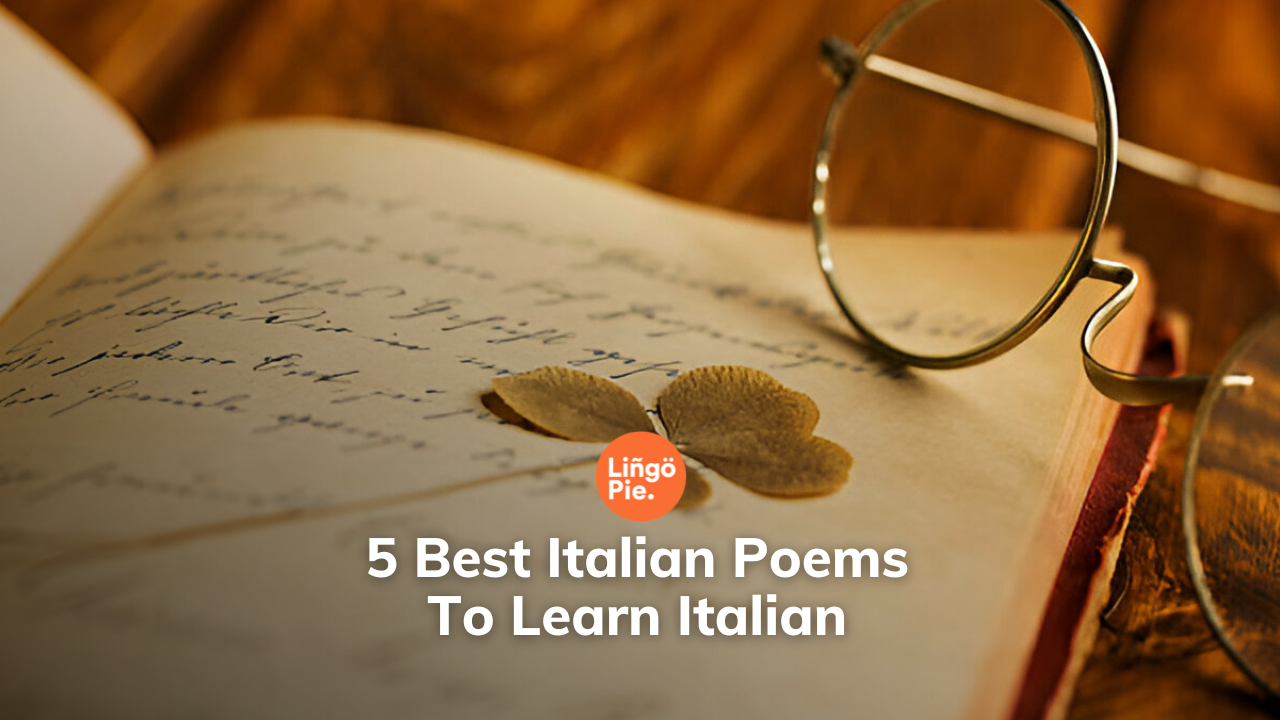Using poems as a language-learning tool offers a lot of benefits that go beyond traditional language-learning methods. Poems provide a window into the soul of a language, offering insights into its culture, history, and emotions. They engage both the intellect and the senses, captivating learners with their rhythm, rhyme, and imagery.
By immersing yourself in Italian poetry, you not only expand your Italian vocabulary and grasp of grammar but also develop a deeper understanding of linguistic nuances and subtleties.
Moreover, poems offer a memorable and enjoyable way to practice pronunciation and intonation, helping you internalize the flow of the Italian language. Through studying Italian poems, you can embark on a journey of discovery, enriching your language skills while simultaneously gaining a deeper appreciation for Italian poetry.

The Beauty of Italian Poetry
Italian poetry is like a treasure trove of stories, feelings, and melodies that have been passed down through the ages. From the olden days of Rome to the bustling streets of modern Italy, it's been a journey filled with passion and creativity. What makes Italian poetry so special is its rhythm—it's like music you can read.
Think of poets like Petrarch, who poured his heart into sonnets, or Dante, who took us on a wild ride through heaven and hell in his "Divine Comedy." Then there's Giacomo Leopardi, who pondered life's big questions, and Gabriele D'Annunzio, who painted pictures with words. These folks weren't just writers—they were magicians who could make emotions dance off the page. Their poems are like windows into Italian culture and history, inviting us to explore the beauty and complexity of life through their words.
Learning Italian Through Poetry
Learning Italian through poetry offers a unique approach that not only improves your language acquisition but also enriches your cultural understanding.
Firstly, poetry serves as a mnemonic device, aiding memory retention by associating words and phrases with rhythmic patterns and emotional resonance. Additionally, the process of reading and analyzing poems provides a profound immersion into Italian grammar and vocabulary. By dissecting the structure of sentences and exploring the nuances of word choice, you can deepen your comprehension of Italian syntax and idiomatic expressions.
To maximize the benefits of poetry as a learning resource, active engagement is key. This includes reading aloud to improve pronunciation, annotating poems to identify linguistic patterns, and engaging in discussions to reinforce comprehension.
By incorporating poetry into your language-learning routine, you not only master your Italian skills but also develop a deeper appreciation for the artistry and cultural significance of the Italian language.
Exploring Italian Poems
For beginners dipping their toes into the world of Italian poetry, there are plenty of accessible options to get started. Poems like "La pioggia nel pineto" by Gabriele D'Annunzio or "L'infinito" by Giacomo Leopardi offer simple language and universal themes that resonate with learners of all levels.
Once you've found a poem that speaks to you, it's time to dive deeper. Break it down like a detective, unraveling the themes, language nuances, and structural elements that make it tick. Pay attention to the imagery, metaphors, and word choices that convey the poet's message. Don't be afraid to consult dictionaries or online resources to decode unfamiliar words or cultural references.
The more you dissect the poem, the more you'll uncover its hidden treasures. And remember, exploring Italian poetry is a journey meant to be enjoyed. So, grab a poem, pour yourself a glass of vino, and start reading these Italian poems!

1. La pioggia nel pineto" by Gabriele D'Annunzio
Taci. Su le soglie
del bosco non odo
parole che dici
umane; ma odo
parole più nuove
che parlano gocciole e foglie
lontane.
Ascolta. Piove
dalle nuvole sparse.
Piove su le tamerici
salmastre ed arse,
piove su i pini
scagliosi ed irti,
piove su i mirti
divini,
su le ginestre fulgenti
di fiori accolti,
su i ginepri folti
di coccole aulenti,
piove su i nostri volti
silvani,
piove su le nostre mani
ignude,
su i nostri vestimenti
leggieri,
su i freschi pensieri
che l'anima schiude
novella,
su la favola bella
che ieri
t'illuse, che oggi m'illude,
o Ermione.
Odi? La pioggia cade
su la solitaria
verdura
con un crepitío che dura
e varia nell'aria
secondo le fronde
più rade, men rade.
Ascolta. Risponde
al pianto il canto
delle cicale
che il pianto australe
non impaura,
nè il ciel cinerino.
E il pino
ha un suono, e il mirto
altro suono, e il ginepro
altro ancóra, stromenti
diversi
sotto innumerevoli dita.
E immersi
noi siam nello spirto
silvestre,
d'arborea vita viventi;
e il tuo volto ebro
è molle di pioggia
come una foglia,
e le tue chiome
auliscono come
le chiare ginestre,
o creatura terrestre
che hai nome
Ermione.
Ascolta, ascolta. L'accordo
delle aeree cicale
a poco a poco
più sordo
si fa sotto il pianto
che cresce;
ma un canto vi si mesce
più roco
che di laggiù sale,
dall'umida ombra remota.
Più sordo e più fioco
s'allenta, si spegne.
Sola una nota
ancor trema, si spegne,
risorge, trema, si spegne.
Non s'ode voce del mare.
Or s'ode su tutta la fronda
crosciare
l'argentea pioggia
che monda,
il croscio che varia
secondo la fronda
più folta, men folta.
Ascolta.
La figlia dell'aria
è muta; ma la figlia
del limo lontana,
la rana,
canta nell'ombra più fonda,
chi sa dove, chi sa dove!
E piove su le tue ciglia,
Ermione.
Piove su le tue ciglia nere
sìche par tu pianga
ma di piacere; non bianca
ma quasi fatta virente,
par da scorza tu esca.
E tutta la vita è in noi fresca
aulente,
il cuor nel petto è come pesca
intatta,
tra le pàlpebre gli occhi
son come polle tra l'erbe,
i denti negli alvèoli
con come mandorle acerbe.
E andiam di fratta in fratta,
or congiunti or disciolti
(e il verde vigor rude
ci allaccia i mallèoli
c'intrica i ginocchi)
chi sa dove, chi sa dove!
E piove su i nostri vólti
silvani,
piove su le nostre mani
ignude,
su i nostri vestimenti
leggieri,
su i freschi pensieri
che l'anima schiude
novella,
su la favola bella
che ieri
m'illuse, che oggi t'illude,
o Ermione.
Themes: The poem explores themes of nature, beauty, and the passage of time. It celebrates the sensory experience of a rainy day in a pine forest, evoking feelings of tranquility and awe.
Language: D'Annunzio's language is rich and descriptive, filled with vivid imagery that transports the reader to the forest. He employs sensory details like the sound of raindrops and the scent of pine, creating a multisensory experience for the reader.
Structure: The poem is structured as a series of stanzas, each depicting a different aspect of the rainy day in the pine forest. The rhythmic flow of the language mimics the gentle patter of rain, enhancing the overall atmosphere of the poem.
2. "L'infinito" by Giacomo Leopardi
Sempre caro mi fu quest'ermo colle,
e questa siepe, che da tanta parte
dell'ultimo orizzonte il guardo esclude.
Ma sedendo e mirando, interminati
spazi di là da quella, e sovrumani
silenzi, e profondissima quïete
io nel pensier mi fingo, ove per poco
il cor non si spaura. E come il vento
odo stormir tra queste piante, io quello
infinito silenzio a questa voce
vo comparando: e mi sovvien l'eterno,
e le morte stagioni, e la presente
e viva, e il suon di lei. Così tra questa
immensità s'annega il pensier mio:
e il naufragar m'è dolce in questo mare.
Themes: Leopardi's poem reflects on the human desire for infinity and the limitations of human existence. It explores themes of longing, existentialism, and the search for meaning in a seemingly indifferent universe.
Language: Leopardi's language is introspective and contemplative, characterized by philosophical musings and existential questions. He uses imagery of nature, such as the horizon and the infinite expanse of the sky, to convey the vastness of the human experience.
Structure: "L'infinito" is structured as a single, uninterrupted monologue, with the speaker reflecting on his encounter with nature and his contemplation of infinity. The poem's repetitive structure, with the refrain "Sempre caro mi fu quest'ermo colle" (This lonely hill was always dear to me), emphasizes the cyclical nature of human longing and the eternal quest for understanding.
3. "Il gelsomino notturno" by Giovanni Pascoli
E s’aprono i fiori notturni,
nell’ora che penso ai miei cari.
Sono apparse in mezzo ai viburni
le farfalle crepuscolari.
Da un pezzo si tacquero i gridi:
là sola una casa bisbiglia.
Sotto l’ali dormono i nidi,
come gli occhi sotto le ciglia.
Dai calici aperti si esala
l’odore di fragole rosse.
Splende un lume là nella sala.
Nasce l’erba sopra le fosse.
Un’ape tardiva sussurra
trovando già prese le celle.
La Chioccetta per l’aia azzurra
va col suo pigolio di stelle.
Per tutta la notte s’esala
l’odore che passa col vento.
Passa il lume su per la scala;
brilla al primo piano: s’è spento...
È l’alba: si chiudono i petali
un poco gualciti; si cova,
dentro l’urna molle e segreta,
non so che felicità nuova.
Themes: Pascoli's poem explores themes of memory, nostalgia, and the passage of time. It reflects on the speaker's recollection of a jasmine flower blooming at night and the emotions it evokes.
Language: Pascoli's language is lyrical and evocative, with vivid imagery that captures the beauty and fragrance of the jasmine flower. He employs sensory details like the scent of the flower and the moonlight filtering through the leaves, creating a dreamlike atmosphere.
Structure: "Il gelsomino notturno" is structured as a single, uninterrupted meditation on the jasmine flower and its significance to the speaker. The poem's language flows smoothly, with a musical rhythm that enhances its emotional impact. Pascoli's use of repetition and alliteration adds to the poem's lyrical quality, drawing the reader deeper into the speaker's reflections.

4. "San Martino" by Giosuè Carducci
La nebbia agl'irti colli
piovigginando sale,
e sotto il maestrale
urla e biancheggia il mar:
ma per le vie del borgo
dal ribollir de' tini
va l'aspro odor dei vini
l'anime a rallegrar.
Gira su' ceppi accesi
lo spiedo scoppiettando;
sta il cacciator fischiando
su l'uscio a rimirar
Tra le rossastre nubi
stormi d'uccelli neri
com'esuli pensieri,
nel vespero migrar.
Themes: "San Martino" celebrates the beauty of autumn and the passage of seasons. It evokes feelings of nostalgia for childhood and the simplicity of rural life.
Language: Carducci's language is vivid and descriptive, painting a picturesque scene of autumnal landscapes and village festivities. He employs sensory details like the crunch of leaves underfoot and the smell of chestnuts roasting, creating a sense of immersion for the reader.
Structure: The poem is structured as a series of stanzas, each depicting a different aspect of autumn. Carducci's use of rhyme and meter adds to the poem's musicality, echoing the rhythm of the changing seasons.
5. "Acquazzone" by Trilussa
Quando a Roma piove un tantino,
nemmeno le pietre stanno al fino.
Dal cielo cade un bel diluvio,
e il fiume straripa sul ponte Milvio.
Aprono gli ombrelli i passanti,
ed anche i cani corrono avanti,
e chi ha una casa corre a casa,
a veder l'acqua che s'abbassa.
Chi sta al riparo in un portone
si scanna il naso col bastone,
chi può si strappa i capelli
a far cader giù i tetti dai tetti.
Ma quando passa il temporale,
bella e lucente come un cristallo,
la città sembra un acquedotto
che va a svuotarsi in un gran pozzo.
E allora spuntano i bel tempo,
lieti e sereni in un baleno,
e tutto il mondo si mette a gridare:
“Viva la pioggia!” senza badare.
Themes: "Acquazzone" humorously depicts the chaos and inconvenience of a sudden rainstorm in the city. It explores themes of everyday life and the unpredictability of nature.
Language: Trilussa's language is colloquial and accessible, written in Roman dialect to reflect the everyday speech of the people. He employs humor and wit to capture the absurdity of the situation, drawing the reader into the scene.
Structure: The poem is structured as a series of quatrains, each describing a different aspect of the rainstorm. Trilussa's use of simple language and straightforward storytelling makes the poem easy to understand and enjoyable to read.
Resources for Italian Poetry
Books:
"Italian Poetry: A Selection from St. Francis of Assisi to Salvatore Quasimodo" by Leonard G. Sbrocchi: This anthology offers a comprehensive collection of Italian poems spanning from the medieval period to the modern era, providing learners with a diverse range of styles and themes to explore.
"Poetry by Heart: A Child's Book of Poems to Remember" by Liz Attenborough: This collection of classic Italian poems, translated into English, is perfect for beginners looking to build their vocabulary and appreciation for Italian verse.
Websites:
Poetry Foundation (www.poetryfoundation.org): The Poetry Foundation website features a vast selection of Italian poems with English translations, as well as articles and resources for poetry enthusiasts of all levels.
Italian Poetry in Translation (italian-poetry.org): This website offers a curated selection of Italian poems translated into English, along with biographical information about the poets and the historical context for each work.
Incorporate Italian Poetry into Your Daily Language Learning Routine
Use Lingopie:
Incorporate Lingopie into your daily language practice routine to immerse yourself in authentic Italian content, including movies, TV shows, and documentaries. Lingopie offers interactive subtitles that allow you to follow along with the dialogue while simultaneously learning new vocabulary and phrases.
By watching Italian films or shows that feature poetry or discussions about literature, you can deepen your understanding of Italian culture and language in a fun and engaging way. You can enhance your listening comprehension, vocabulary acquisition, and overall fluency in Italian with Lingopie!
Download Lingopie from the App Store or Play Store now and get a FREE 7-day trial!
Read Italian Poems Aloud:
Set aside time each day to read and recite Italian poems aloud. Choose poems that resonate with you and challenge yourself to pronounce the words with correct intonation and rhythm.
Analyze Italian Poems:
Take a few minutes each day to analyze a stanza or verse from an Italian poem. Break down the language, identify literary devices, and explore the deeper meanings behind the words.
Write Your Own Poem in Italian:
Practice writing your own Italian poems as a way to reinforce vocabulary and grammar skills. Start with simple verses and gradually work your way up to more complex forms, such as sonnets or villanelles.
Memorize Italian Poems:
Memorize your favorite Italian poems and recite them from memory throughout the day. This will not only improve your language skills but also enhance your ability to express yourself fluently in Italian.
By incorporating these resources and practices into your language learning routine, you can deepen your understanding of Italian poetry while simultaneously mastering your language skills. Buona fortuna!
Final Words
So, wrapping it up: learning Italian through poetry? It's like hitting two birds with one stone. You're not just picking up words and grammar rules—you're immersing yourself in the heart and soul of the language.
And hey, the journey doesn't have to stop here. There's a whole world of Italian literature waiting for you to explore. So, why not keep digging? Keep reading those poems, diving into stories, and picking up all that Italian vocabulary!






![How Many Italian-Speaking Countries Are Out There? [2025 Data]](/blog/content/images/size/w300/2025/06/Italian-speaking-countries.jpg)


